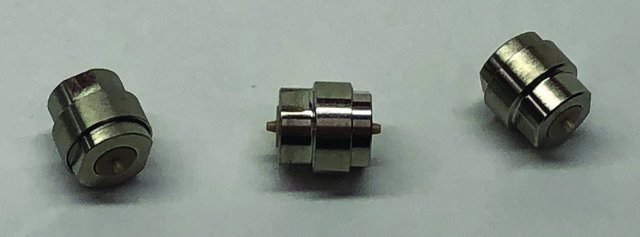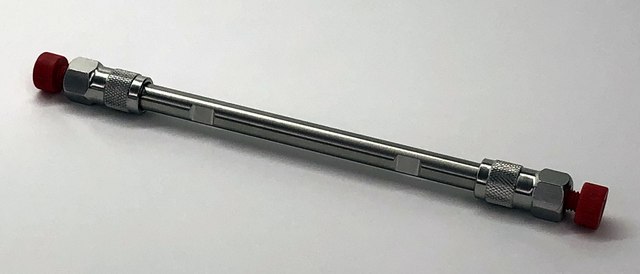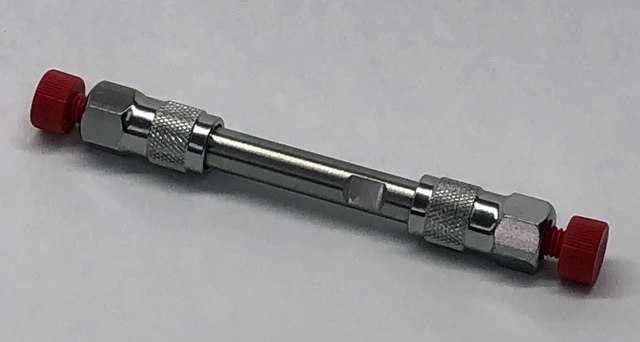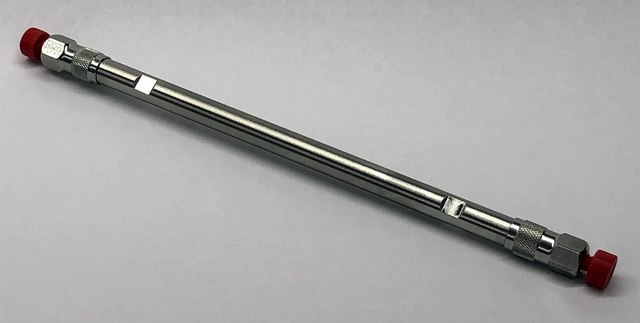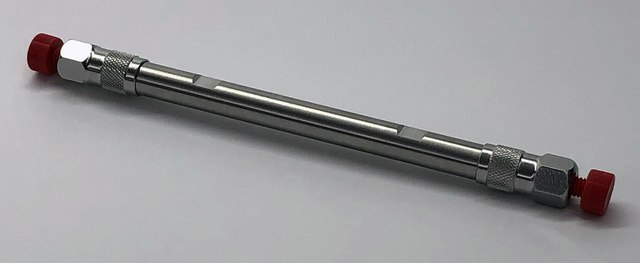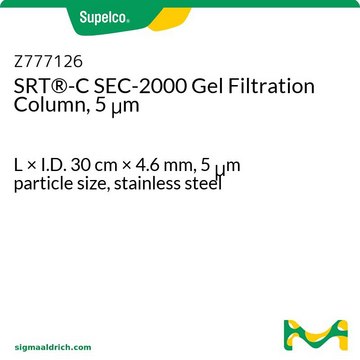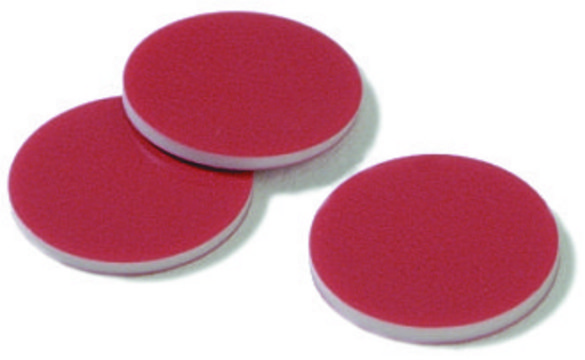推荐产品
产品名称
Ascentis® Express HILIC, 5 μm HPLC Column, 5 μm particle size, L × I.D. 10 cm × 4.6 mm
物料
stainless steel column
质量水平
Agency
suitable for USP L3
产品线
Ascentis®
特点
endcapped: no
制造商/商品名称
Ascentis®
包装
1 ea of
参数
60 °C temp. range
600 bar max. pressure (9000 psi)
技术
HPLC: suitable
LC/MS: suitable
长度 × 内径
10 cm × 4.6 mm
表面积
90 m2/g
杂质
<5 ppm metals
基质
Fused-Core particle platform
superficially porous particle
基质活性基团
silica phase
粒径
5 μm
孔径
90 Å pore size
工作pH值
1-8
应用
food and beverages
分离技术
hydrophilic interaction (HILIC)
normal phase
正在寻找类似产品? 访问 产品对比指南
一般描述
Column Characteristics
The Fused-Core particle has a surface area of ~ 100 m2/g and an average pore size of 90Å. The Fused-Core particles are 30% to 50% heavier than commercially available totally porous particles due to the density of the solid cores. Therefore, the effective surface area per column is similar to columns packed with totally porous particles having surface areas in the 160-200 m2/g range.
法律信息
未找到合适的产品?
试试我们的产品选型工具.
储存分类代码
11 - Combustible Solids
WGK
WGK 3
闪点(°F)
Not applicable
闪点(°C)
Not applicable
从最新的版本中选择一种:
分析证书(COA)
Which document(s) contains shelf-life or expiration date information for a given product?
If available for a given product, the recommended re-test date or the expiration date can be found on the Certificate of Analysis.
How do I get lot-specific information or a Certificate of Analysis?
The lot specific COA document can be found by entering the lot number above under the "Documents" section.
How do I find price and availability?
There are several ways to find pricing and availability for our products. Once you log onto our website, you will find the price and availability displayed on the product detail page. You can contact any of our Customer Sales and Service offices to receive a quote. USA customers: 1-800-325-3010 or view local office numbers.
What is the Department of Transportation shipping information for this product?
Transportation information can be found in Section 14 of the product's (M)SDS.To access the shipping information for this material, use the link on the product detail page for the product.
Can peptide or protein samples be analyzed using HILIC columns?
Polar peptides are quite amenable to HILIC separations; however, our experience with larger peptides has been only minimally successful - mainly due to solubility issues. Proteins are even more difficult due to the same issue. An additional problem with proteins is that they are often multiply charged. When IEX is performed on multiply charged analytes, you often get what is referred to as a rolling effect where the analyte interacts with ionic sites on the surface in many different ways as it 'rolls' down the column; this produces broad and misshapen peaks.
Would you advise addition of a buffer when using diol or amide stationary phase?
Yes. if possible you should always have at least a small amount of buffer in a HILIC system to help mediate/control IEX and other polar interactions that are bound to be present (even if at a low level). It is not so much the "buffering capacity" that is important, but the presence of the competing ions. We have found that their presence helps with day to day and column to column reproducibility. There are times when you need to eliminate the buffer, but aside from special circumstances, our recommendation is to include them.
How does the flow rate influence the water layer on the column?
We are not aware of any systematic studies with respect to the impact of flow rate on HILIC separations. Our concern would be that as you move to higher flow rates, you might observe peak shape issues due to the slow kinetics of IEX and adsorption mechanisms. If the retention mechanisms for a given system are partition dominated, this should be of less concern. It will be a case by case cause and effect.
Why is it recommended to run isocratically for HILIC methods?
When running in HILIC mode, both isocratic and gradient practices result in instability. If you keep the re-equilibration times constant, gradient should not be a problem, but changing this parameter can have a significant impact. It is not so much that it is bad as it is different than we are used to in reversed phase. Usually, we assume that once equilibrated (5, 10, 15 min, etc.), we can leave the system for any time period and come back to the same results. This does not appear to be the case in our studies of HILIC. Knowing that the re-equilibration time has an impact, you should get in the habit of making several injections with known re-equilibration times prior to making any development decisions. To get around this, isocratic runs are recommended. Attached are two posters; the first was presented at HPLC 2013 (Amsterdam) and the second was presented at Balaton Symposium on High Performance Separation Methods 2013 (Hungary). Both show 'reproducibility' at any set re-equilibration time is good but both show that if you change the re-equilibration time; then retention, peak shape and selectivity can change especially where ionic interactions are prevalent.
When you recommend only changing one parameter at a time, does this also refer to the total ionic strength?
If you change organic, try to keep the overall buffer concentration (and all other parameters, for that matter) constant. There are times when you will want to change both and perhaps pH/temp/etc. simultaneously, but that drastically complicates the system and thus should be avoided, if possible.
When referring to the pH of the mobile phase (pH 3, pH 4, etc.), does that refer to the aqueous part of the mobile phase?
Typically when we refer to pH in HILIC, we use the effective pH or the pH as measured after the addition of organic. The point is that we should always define what pH we are stating. The common way to distinguish is using notation of w/w pH or s/w pH (usually superscript/subscript). The notations mean superscript = solvent the pH is measured in (s would indicate some mixture of aqueous:organic) and the subscript = the solvent the pH meter is calibrated in (typically water (or w) as we readily have calibration standards).
What column do you recommend for an anionic compound?
If the acids are hydrophilic or you can adjust the pH to make them hydrophilic enough, any of the phases that exhibit HILIC partitioning are possible (bare silica, OH5, diol, Zwitterionic, amide). We typically go with the OH5 first to try and avoid any negative impacts on the like charge.
In HILIC separations, what happens if the sample is an aqueous matrix? Does it always have a negative effect?
Yes, it would be highly preferential (especially in this case where you want partitioning to dominate) to inject in high organic. That said, you can 'get away' with it if the injection volume can be kept small - much like we can inject low volumes of stronger solvents in RP mode, if needed. What you will want to do to minimize impact is to get as much retention on the analytes of interest as you can, this helps give the sample solvent some time to dissipate and negate the effects.
How should I store the Ascentis Express HILIC column?
Long-term storage of silica-based columns is best in 100% acetonitrile. Columns may be safely stored for short periods (up to 3 or 4 days) in most common mobile phases. However, when using buffers, it is best to remove the salts to protect both the column and the HPLC equipment by first flushing the column with the same mobile phase without the buffer (e.g., when using 90/10 ACN/buffer, flush the column with 90/10 ACN/H2O) to eliminate any concern about salt precipitation or corrosion from the salts then flush the column with 100% acetonitrile for storage.Before storing the column, the end-fittings should be tightly sealed with the endplugs that came with the column to prevent the packing from drying.
What steps should be taken to maximize column life?
To maximize column life, ensure that samples and mobile phases are particle-free. The use of guard columns or an in-line filter with 0.5 μm porosity between the sample injector and the column is highly recommended. The 2 μm porosity frits on Ascentis Express 5 μm HILIC columns are less subject to pluggage than are the 0.5 μm frits typically used with other small-particle columns. Should the operating pressure of the column suddenly increase beyond normal levels, reversing the flow direction of the column may be attempted to remove debris on the inlet frit.
My question is not addressed here, how can I contact Technical Service for assistance?
Ask a Scientist here.
我们的科学家团队拥有各种研究领域经验,包括生命科学、材料科学、化学合成、色谱、分析及许多其他领域.
联系技术服务部门